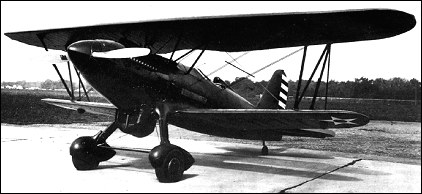|
| The Curtiss XP-23 was the last biplane in the pursuit series. In most respects an entirely new design and a very graceful one, it was altered on the production line from the final airframe among the 45 which were ordered as Y1P-22 but redesignated P-6E. The ubiquitous 447kW Curtiss V-1570 Conqueror was again called-up for service, initially with a turbo-charger and three-blade propeller. Delivered 16 April 1932 and evaluated by operational fighter pilots at Wright Field, the XP-23 seems to have performed very well, subject only to the limitations of the double-wing configuration. Some reports that the XP-23 was excessively heavy, with maximum take-off weight as high as 1950kg appear to be based on an erroneous interpretation of Curtiss documents from the period. The XP-23 flew like it looked, a sleek, potent fighter denied a production contract only because, in 1932, it was competing not with other biplanes but with the monoplane Boeing P-26 'Peashooter'.
The aircraft reached the service-test stage with turbo-charger removed, two-blade propeller retrofitted, and its designation changed to YP-23. Eventually, despite speed and manoeuvrability fully competitive with that of the Boeing monoplane, it became clear that the US Army would choose the latter as its standard fighter of the early 1930s. Ultimately, the YP-23 was deleted from Army inventory and turned back to Curtiss, where its wings were retained for use on the prototype US Navy XF11C-1 shipboard fighter. It may be symbolic that the wings lasted longer than the fuse-lage: never again would paired wings adorn a pursuit/fighter aircraft.
 | A three-view drawing (1280 x 938) |
| WEIGHTS |
| Take-off weight | 1542 kg | 3400 lb |
| Empty weight | 1315 kg | 2899 lb |
| DIMENSIONS |
| Wingspan | 9.60 m | 32 ft 6 in |
| Length | 7.26 m | 24 ft 10 in |
| Height | 2.90 m | 10 ft 6 in |
| Wing area | 23.23 m2 | 250.05 sq ft |
| PERFORMANCE |
| Max. speed | 327 km/h | 203 mph |
| Ceiling | 7925 m | 26000 ft |
| Range | 700 km | 435 miles |
| ARMAMENT | 1 x 12.7mm + 1 x 7.62mm fixed machine-guns, 227kg of bombs |
| mitchell, e-mail, 26.11.2009 00:06 just wondering if i could possibly take the drawing of this plane and edit it to use it in a company logo? reply |
|
Do you have any comments?
|
| 
COMPANY
PROFILE
All the World's Rotorcraft
|







